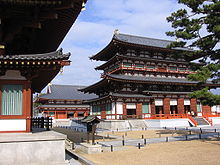Yakushi-ji
The Yakushi-ji ( Japanese 薬 師 寺 ) is a Buddhist temple and the main temple of the Hosso sect . It is located in Nishinokyo , the northwestern part of the city of Nara in Japan . Mainly the Buddha Yakushi is venerated in it.
history
The construction of the temple was planned in the year 680 of the Temmu -tennō in order to pray for the recovery of his seriously ill wife, Jitō . The actual building ( 34 ° 29 ′ 33.9 ″ N , 135 ° 48 ′ 1 ″ E ) was built after Temmus' death under the guidance of Empress Jitō in Fujiwara , south of Nara (today's city of Kashihara ) and was built in 697 or 698 completed. After the capital of Japan moved to Heijō-kyō (Nara) in 710 , the Yakushi-ji was also moved there in 718 and expanded. Since the first written evidence of the Japanese language was made after the move, it is unclear which of the older buildings date from the Nara period or from the Asuka period .
Most of the buildings in the temple complex were destroyed over the centuries in civil wars, great fires (especially in 973 and 1528) or other natural disasters such as typhoons. The eastern pagoda ( 東 塔 , Tōtō ) is the only building from the 7th or 8th century that has not been restored. The western pagoda ( 西塔 , Saitō ) burned down completely in 1528 and was rebuilt in 1981. Except for the eastern pagoda and the eastern hall ( 東 院 堂 , Tōindō ), all current buildings date from the last few decades. The first work was completed in 1976 on the main hall ( Kondō ). After the reconstruction of the western pagoda (1981), the most recent restoration of the Great Prayer Hall ( 大 講堂 , Daikōdō ), the largest building on the temple grounds, was completed in 2003.
The 33.6 meter high eastern pagoda appears to have six floors, but there are only three. The other "floors" are additional intermediate roofs ( mokoshi ) and are smaller than the real floors. This roof construction style is very rare. Ernest Francisco Fenollosa is said to have spoken of it as "frozen music". Also famous is the 10 meter high and three tonne top of the pagoda ( 相 輪 , Sōrin ), which combines various religious symbols, serves as a lightning rod and is important for the structural stability of the pagoda.
In 1952 the complex was declared a special historical site ( tokubetsu shiseki ). In 1998, Yakushi-ji was declared a World Heritage Site by UNESCO, along with other historical monuments in Nara . The eastern pagoda, the eastern hall, the three Yakushi statues and other statues are also among the national treasures of Japan .
Web links
- 3D images
- 3D images
- Historical outline ( Memento from March 4, 2016 in the Internet Archive )
Coordinates: 34 ° 40 ′ 6.2 ″ N , 135 ° 47 ′ 3.6 ″ E


